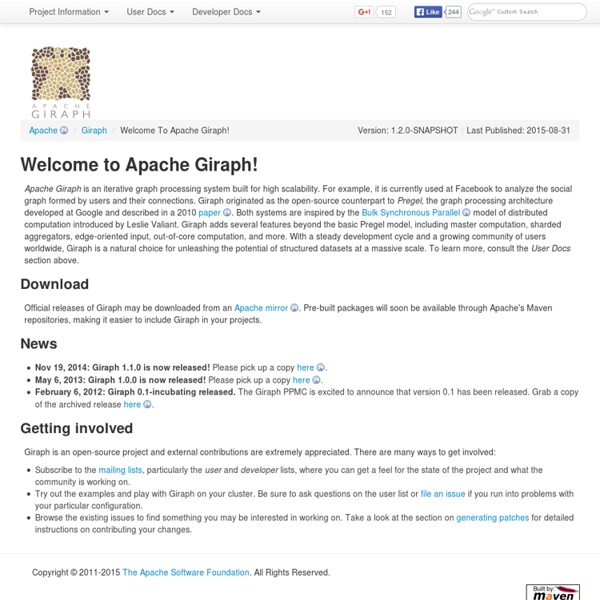



Stig Database Apache Giraph References[edit] External links[edit] Official website structr.org - Home Making Hadoop 1000x Faster for Graph Problems Dr. Daniel Abadi, author of the DBMS Musings blog and Cofounder of Hadapt, which offers a product improving Hadoop performance by 50x on relational data, is now taking his talents to graph data in Hadoop's tremendous inefficiency on graph data management (and how to avoid it), which shares the secrets of getting Hadoop to perform 1000x better on graph data. Analysing graph data is at the heart of important data mining problems.Hadoop is the tool of choice for many of these problems.Hadoop style MapReduce works best on KeyValue processing, not graph processing, and can be well over a factor of 1000 less efficient than it needs to be.Hadoop inefficiency has consequences in real world. Voila! That's a 10x * 10x * 10x = 1000x performance improvement on graph problems using techniques that make a lot of sense. What I found most intriguing is thinking about the larger consequences of Hadoop being inefficient.
Facebook's Graph Search puts Apache Giraph on the map Move over Hadoop, there is another highly scalable data-processing powerhouse in town: Apache Giraph. Facebook is using the technology to bring a new style of search to its billion users. When Facebook built its Graph Search service, the social-networking company picked Giraph over other social graphing technologies—such as the Hadoop-based Apache Hive and GraphLab—because of Giraph’s speed and immense scalability. “Analyzing these real-world graphs at our scale ... with available software was impossible last year. We needed a programming framework to express a wide range of graph algorithms in a simple way and scale them to massive datasets,” wrote Facebook software engineer Avery Ching, in a blog post that discussed Facebook’s use of the technology. With a little modification, Facebook has used Giraph to analyze a trillion edges, or connections between different entities, in under four minutes. Facebook's Graph Search Facebook Giraph's background
Quick 'n' Comfortable Web Development in PHP | Nette Framework MongoGraph - MongoDB Meets the Semantic Web Scaling Apache Giraph to a trillion edges Spring How to Build an SQL Storage Adapter for RDF Data with Ruby - The Datagraph Blog RDF.rb is approaching two thousand downloads on RubyGems, and while it has good documentation it could still use some more tutorials. I recently needed to get RDF.rb working with a PostgreSQL storage backend in order to work with RDF data in a Rails 3.0 application hosted on Heroku. I thought I'd keep track of what I did so that I could discuss the notable parts. In this tutorial we'll be implementing an RDF.rb storage adapter called RDF::DataObjects::Repository, which is a simplified version of what I eventually ended up with. I'll mention, briefly, that I chose DataObjects as the database abstraction layer, but I don't want to dwell on that -- this post is about RDF. Requirements You just need a few gems for the example repository. $ sudo gem install rdf rdf-spec rspec do_sqlite3 Testing First So where do we start? If you haven't seen something like this before, that's an RSpec shared example group, and it's awesome. $:.unshift File.dirname(__FILE__) + "/.. $ spec -cfn spec/sqlite3.spec
Facebook’s trillion-edge, Hadoop-based and open source graph-processing engine People following the open source Giraph project likely know that Facebook was experimenting with it, and on Wednesday the company detailed just how heavily it’s leaning on Giraph . Facebook scaled it to handle trillions of connections among users and their behavior, as the core of its Open Graph tool. Oh, and now anyone can download Giraph, which is an Apache Software Foundation project, with Facebook’s improvements baked in. Graphs, you might recall from our earlier coverage, are the new hotness in the big data world . Giraph is an open source take on Pregel , the graph-processing platform that powers Google PageRank, among other things. Even though it’s not using a specially built graph-processing engines, Pinterest utilizes a graph data architecture as a way of keeping track who and what its users are following. There are several other popular open source graph projects, as well, including commercially backed ones such as Neo4j and GraphLab . Source: Facebook
Play Framework - Build Modern & Scalable Web Apps with Java and Scala Parliament High-Performance Triple Store About Structr in short Structr (pronounced 'structure') is a Java framework for mobile and web applications based on the graph database Neo4j, with a supplement UI providing CMS functionality to serve pages, files and images. It was designed to simplify the creation and operation of graph database applications by providing a comprehensive Java API with a built-in feature set common to most use cases, like e.g. authentication, users and groups, constraints and validation, etc.. Status Structr is under constant development, and already used in production in several projects. Your feedback - positive or negative - is always appreciated! Getting Started To get Structr up and running in ten minutes, follow the Quick Start Guide, or go to the Download Page to get instructions how to install Structr on your platform. Structr Backend The Structr backend is the foundation of any Structr system but can also be used stand-alone as high performance, domain-focused REST server for Neo4j. JSON/REST Interface Tools